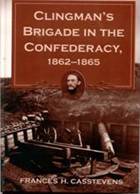BOOKS BY
FRANCES H. CASSTEVENS
For
autographed copies of my books,
Send
check or money order to above address.
Prices listed
below beside each individual book.
Return to my Home Page: The Yadkin County Country Store
[Note:
All
REGIONAL HISTORY: Featuring

 Death in
Death in
Price
$20 (plus $4.00 postage). Paperback, published 2006 by The History Press,
123-page book includes 10 true crime stories, some of which achieved nation-wide fame. Among the fascinating stories is the murder of Captain James West, February 1863), in the skirmish at the Bond School House; the murder of hired-hand Will Kelly in the barnyard of the Dalton-Hunt house; the murder of Laura Foster for which Tom Dula was hanged; the murder of “Poor” Ellen Smith near the first Zinzendorf Hotel in Winston(-Salem), NC; the Lawson family murders on Christmas day, 1929; and the mysterious death of Zachary Smith Reynolds at Reynolda House in Winston-Salem in 1932.
This book is a must for collectors of local history.
*Winner of the Willie
Parker Peace Award presented by the
Regional Folklore and Ghost Stories


Ghosts and Their Haunts: The Legends and Lore of the
Price
$15 (plus $4.00 postage). 2nd Edition. Paperback published in 2007 by Catawba
Publishing Co.,
This 158-page book is an assortment
of ghost stories, legends and folklore from all the counties that border the
Great book
for old and young alike.
The War Between the States, a.k.a. the
Civil War
Note: All of my Civil War Books are thoroughly
researched, annotated, referenced and indexed.

 The Civil War and
The Civil War and
Price $32 (plus $4.00 postage). 2nd edition,
paperback, published in 2005 by McFarland & Co.
This was the first in my
series about the War Between the States (1861-1865). It provides the reader with an overview of
life in
The raid of General George Stoneman’s Federal cavalry in the spring of 1865 through
Jonesville, Hamptonville and
*Winner of the Willie Parker Peace Award from the

 Clingman’s
Brigade in the Confederacy, 1862-1865.
Clingman’s
Brigade in the Confederacy, 1862-1865.
Price $45.00 (plus $4 postage) Hardcover only, published 2002 by McFarland
& Co.
Thomas L. Clingman,
born in
and enter politics.
He served in both houses of the U. S. Congress. When
The
book focuses on the regiments of Clingman’s
brigade. Included are two of Clingman’s order books which show in detail the myriad of
problems a brigadier general faced ever day in the management of a brigade.

 Edward A. Wild and the
African Brigade in the Civil War.
Edward A. Wild and the
African Brigade in the Civil War.
Price $37
(plus $4 postage). Published in 2003 by
McFarland & Co. Hardcover, 325 pages, photos, endnotes, bibliography, index.
Despite being one of those hated “Yankees,” this was a man I cam to admire. He accomplished much with the most severe
handicaps—he lost his arm at
Wild seemed to have a talent for getting in sticky
situations. After a raid into the
northeastern counties of coastal
After the war, Wild joined the Freedmen’s Bureau in
Edward A. Wild is one of those unforgettable characters who
has been overlooked by historians.

 George
W. Alexander and Castle Thunder: A Prison and its Commandant.
George
W. Alexander and Castle Thunder: A Prison and its Commandant.
Price $42, hardcover; $32 paperback. Originally published in 2004. reprinted in paperback in 2007.
263 pages ,
photos, partial listing of prisoners held in Castle Thunder.
George Washington Alexander
served in the U. S. Navy as an officer under Commodoer
Perry in the history-making voyage to
He returned to
Alexander had other
talents. While running the prison, he
wrote a play, Virginia Cavalier, which
was performed in
After the war, Alexander was
on the 10-Most-Wanted list, and he fled to
Of interest to Civil War
buffs, a partial listing of prisoners housed in Castle Thunder is
included.

 Tales
from the North and the South:
Twenty-four Remarkable People and Events of the Civil War.
Tales
from the North and the South:
Twenty-four Remarkable People and Events of the Civil War.
Price. $35.00 (plus $4
postage).
Shown on the cover is a statue that was erected at
A chapter is devoted to Brigadier General Stand Watie, a Cherokee Indian who fought bravely for the
Confederacy. Miss Elizabeth Van Lew, a
Former slave, Mrs. Susie Baker King Taylor, taught blacks to read, and later was involved in the Women’s Suffrage movement. Dr. Mary Walker, the first woman doctor in the Union army, was awarded a Congressional Medal of Honor (and had it recalled).
These are just a few of the stories in this book. It is an interesting and readable book, suitable for people of all ages.

“Out of the Mouth of Hell:” Civil War Prisons
and Escapes.
Price $55 (plus $4 postage). Hardcover, published 2005, McFarland &
Co.
This highly acclaimed book examines both Confederate and Federal prisons, a total of 27. Conditions in all were horrible, disease rampant, and the food bad to non-existent. Each chapter features a prison, gives its location, capacity, and description of the facility. Included are true stories of daring escapes and failed attempts. Some plans were shear genius.
Only about 12 prisoners escaped from the Federal prison on
Johnson’s Island in
Some of the prisons are famous (Andersonville, Libby, Castle Thunder), while others are scarcely known (Danville, VA; Camp Davidson at Savannah, GA; Rock Island, IL; and Alton Military Prison, Alton, IL, Gratiot Street Prison, St. Louis, MO).
The escape of Confederate cavalry officer, John Hunt Morgan, and a few of his men, from the Ohio State Penintentiary is one of the more interesting stories.
The ability of men to survive in the most horrible conditions, much less escape, is almost unbelievable , as can be seen from some of the stories in this book.
The 28th Regiment,